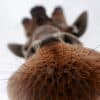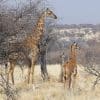Up until now, scientists and the world had only recognised a single species of giraffe made up of several subspecies. But, according to the most inclusive genetic analysis of giraffe relationships to date, giraffe actually are not one species, but four. For comparison, the genetic differences among giraffe species are at least as great as those between polar and brown bears.
The unexpected findings reported in Current Biology on 8 September 2016 highlights the urgent need for further and in-depth study of the four genetically isolated species and for greater conservation efforts for the world’s tallest mammal, the researchers say.
“We were extremely surprised, because the morphological and coat pattern differences between giraffe are limited,” says Dr. Axel Janke, a geneticist at the Senckenberg Biodiversity and Climate Research Centre and Goethe University in Germany. “Giraffe are also assumed to have similar ecological requirements across their range”, he added, “but no one really knows, because this megafauna has been largely overlooked by science.”
Giraffe are in dramatic decline across their range in Africa. Their numbers have dropped substantially over the last three decades, from more than 150,000 individuals to fewer than 100,000. Despite that, the researchers say that there has been relatively little research done on giraffe in comparison to other large animals, such as elephants, rhinoceroses, gorillas, and lions.
About five years ago, Dr. Julian Fennessy of Giraffe Conservation Foundation (GCF) based in Namibia approached Dr. Janke to assist with genetic testing of the giraffe. Dr. Fennessy wanted to know how similar (or not) giraffe living in different parts of Africa were to each other, whether past translocations of giraffe individuals had inadvertently “mixed” different species or subspecies, and, if so, what should be done in future translocations of giraffes into parks or other protected areas.
In the new study, the collaborative research team examined the DNA evidence taken from skin biopsies of 190 giraffe collected by Dr. Fennessy and partners all across Africa, including regions of civil unrest. The extensive sampling includes populations from all nine previously recognised giraffe subspecies.
The genetic analysis shows that there are four highly distinct groups of giraffe, which apparently do not mate with each other in the wild. As a result, they say, giraffe should be recognised as four distinct species. Those four species include (1) northern giraffe (Giraffa camelopardalis), (2) southern giraffe (Giraffa giraffa), (3) reticulated giraffe (Giraffa reticulata), and (4) Masai giraffe (Giraffa tippelskirchi). Both southern and northern giraffe have two and three distinct subspecies respectively: Angolan (G. g. angolensis) and South African giraffe (G. g. giraffa) for southern giraffe, and Kordofan (G. c. antiquorum), Nubian (G. c. camelopardalis) and West African giraffe (G. c. peralta) for northern giraffe. The latter includes the elusive Nubian giraffe from Ethiopia and the South Sudan region – samples collected collaboratively with African Parks Network and Wildlife Conservation Society, which was the first described some 300 years ago and is the nominate species, Dr. Fennessy says.
The discovery has significant conservation implications, the researchers say, noting that the International Union for Conservation of Nature and Natural Resources (IUCN) Species Survival Commission (SSC) Giraffe and Okapi Specialist Group recently submitted an updated proposed assessment of the giraffe for the IUCN Red List (still under review by IUCN) taking into consideration their rapid decline over the last 30 years.
“With now four distinct species, the conservation status of each of these can be better defined and in turn hopefully added to the IUCN Red List in time.” Dr. Fennessy says. “Working collaboratively with African governments, the continued support of the Giraffe Conservation Foundation and partners can highlight the importance of each of these dwindling species, and hopefully kick start targeted conservation efforts and internal donor support for their increased protection.
“As an example,” he adds, “northern giraffe number less than 4,750 individuals in the wild, and reticulated giraffe number less than 8,700 individuals—as distinct species, it makes them some of the most endangered large mammals in the world and require doubling of protection efforts to secure these populations.
The conservation implications from this work are immense and our findings will hopefully help put giraffe conservation on the global map. It is important to note that in addition to this work GCF has monitored the decline of giraffe populations throughout Africa as well as the continued and increasing threats they face. Based on a combination of all these findings we are increasing our support on the conservation of targeted giraffe species and populations and need your support to make this a reality.” says Dr Fennessy.
Drs. Janke and Fennessy say that they are now analysing the amount of gene flow between the giraffe species in greater detail. In addition to expanding the ecological and species distribution data, they want to better understand the factors that limit gene flow and the giraffes’ differentiation into four species and several subspecies.
###
This study was supported by the State of Hesse’s funding program LOEWE, the Leibniz Association, the Giraffe Conservation Foundation, the Leiden Conservation Foundation, Auckland Zoo, and various African government partners and international supporters.
Current Biology, Fennessy et al.: “Multi-locus Analyses Reveal Four Giraffe Species Instead of One”.








WOW this is big!!! And also very intriguing. It is so funny that something that has been assumed forever has totally warped just like that. Someone just had to care enough to find out.
I absolutely love giraffes and I’m so glad i can live now to learn more and more about them. Can’t wait to see future breakthroughs and improvement on conservation. Bc i KNOW your efforts will pay off. Much love… 🙂
Saw the news in Australia have posted and shared and I plan to donate it brakes my heart that this is a reality I hope we can stop the unthinkable from happening I m now 21 and have loved giraffes since I was about 10 when I saw one be born here in Australia at our zoo in Melbourne. I hope we can savget them will pray for them. ????????